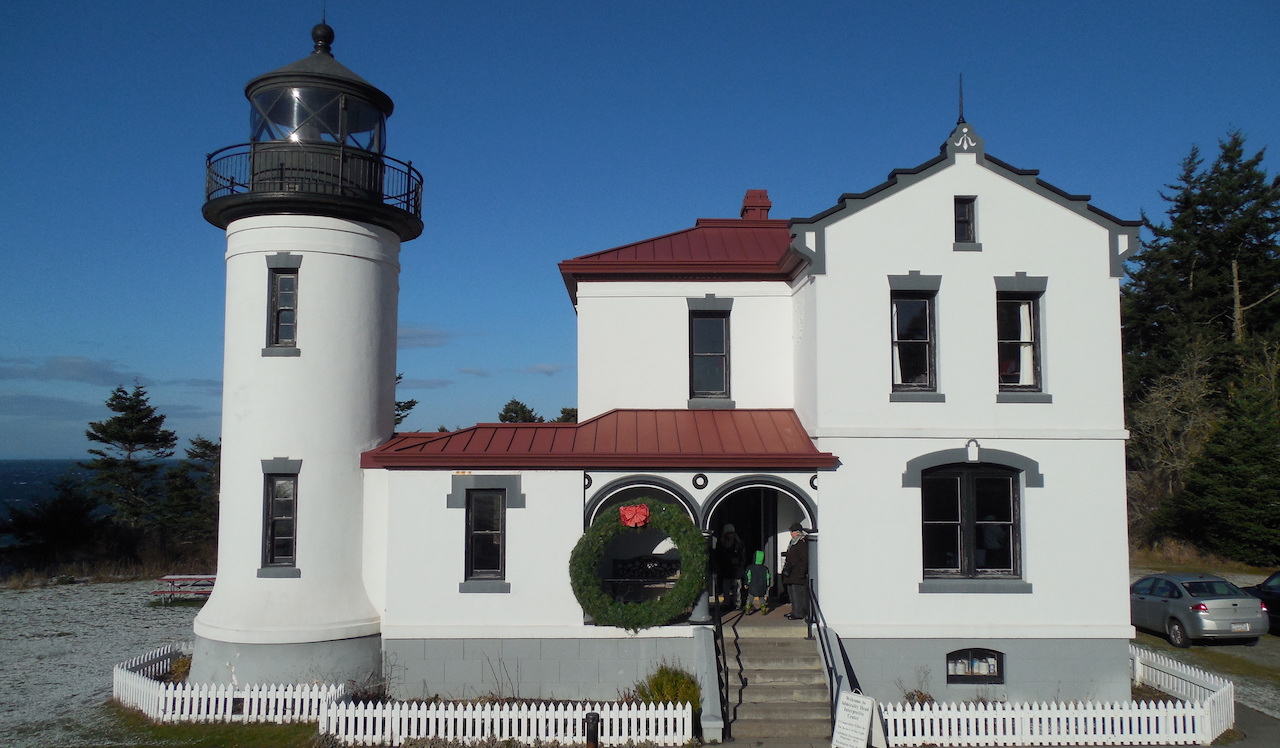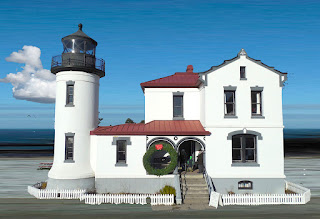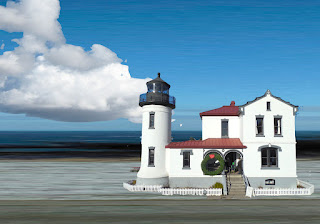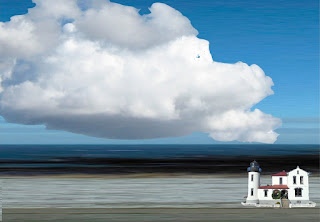Using Contrast to Tell a Tale
Contrast is one of those tools we can use to make a subject interesting: contrast of size, color, or color value. I was reminded of how much fun a contrast in size can be while studying a picture of the lighthouse on Whidbey Island.
Whidbey Island is a short ferry ride from Seattle, and although the Admiralty Head Lighthouse was deactivated in 1927, it’s been restored as a highlight of Fort Casey State Park. (Both the lighthouse and the fort were important in the defense of Puget Sound in 1890, but the fort’s guns were removed before the beginning of World War I.)
Nevertheless, the restored lighthouse still makes a striking image—bold white architecture against the coast and sky. The contrast between the white building, the dark evergreens, and the (sometimes) deep blue sky seem ready-made for a painting.
The problem I found when trying to use the building a subject for painting is that if it fills the page, it suddenly seems so imposing and rigid that the picture seems to freeze into lifelessness.

Since I had also become fascinated with clouds and sunsets, I began experimenting with some photographs to see how a few clouds might help make the lighthouse’s image seem more dynamic. Clouds, after all, could bring
-
Contrasting shape—the soft organic shapes of the clouds in contrast to the sharply etched lighthouse
-
Contrasting color—the vivid colors of clouds at sunset contrasting with the white lighthouse, and of course,
-
Contrasting texture—the hard, smooth lighthouse contrasting with the clouds’ fluffiness
As I began to introduce clouds into my photograph, I discovered one more contrast: the contrast of scale. This contrast seemed to hold the most interesting possibilities, since it most easily seems to tell a story about the lighthouse. Notice what happens.
If, for example, we introduce a tiny cloud into the picture, the lighthouse seems as imposing as ever, and the cloud seems an insignificant afterthought. However, the lighthouse still retains much of its former stiffness. This arrangement suggests a no-nonsense lighthouse that is “all business.”

If we make the size of the lighthouse about equal, an interesting tension develops between the two objects. In this arrangement, the lighthouse is a place where lots of things could happen. The diagonal line that the cloud makes adds to the dynamics.

If we make the cloud dominate the picture, the lighthouse suddenly becomes a lonely, vulnerable place.

Changing the relative scale of the two objects doesn’t just change the composition. It changes the story that the picture tells.
But don't just read about using size and emphasis. Experiment with it in an art lesson!
Get your art lesson and draw the Whidbey Island lighthouse today!
Contrast is one of those tools we can use to make a subject interesting: contrast of size, color, or color value. I was reminded of how much fun a contrast in size can be while studying a picture of the lighthouse on Whidbey Island.
Whidbey Island is a short ferry ride from Seattle, and although the Admiralty Head Lighthouse was deactivated in 1927, it’s been restored as a highlight of Fort Casey State Park. (Both the lighthouse and the fort were important in the defense of Puget Sound in 1890, but the fort’s guns were removed before the beginning of World War I.)
Nevertheless, the restored lighthouse still makes a striking image—bold white architecture against the coast and sky. The contrast between the white building, the dark evergreens, and the (sometimes) deep blue sky seem ready-made for a painting.
The problem I found when trying to use the building a subject for painting is that if it fills the page, it suddenly seems so imposing and rigid that the picture seems to freeze into lifelessness.

Since I had also become fascinated with clouds and sunsets, I began experimenting with some photographs to see how a few clouds might help make the lighthouse’s image seem more dynamic. Clouds, after all, could bring
-
Contrasting shape—the soft organic shapes of the clouds in contrast to the sharply etched lighthouse
-
Contrasting color—the vivid colors of clouds at sunset contrasting with the white lighthouse, and of course,
-
Contrasting texture—the hard, smooth lighthouse contrasting with the clouds’ fluffiness
As I began to introduce clouds into my photograph, I discovered one more contrast: the contrast of scale. This contrast seemed to hold the most interesting possibilities, since it most easily seems to tell a story about the lighthouse. Notice what happens.
If, for example, we introduce a tiny cloud into the picture, the lighthouse seems as imposing as ever, and the cloud seems an insignificant afterthought. However, the lighthouse still retains much of its former stiffness. This arrangement suggests a no-nonsense lighthouse that is “all business.”

If we make the size of the lighthouse about equal, an interesting tension develops between the two objects. In this arrangement, the lighthouse is a place where lots of things could happen. The diagonal line that the cloud makes adds to the dynamics.

If we make the cloud dominate the picture, the lighthouse suddenly becomes a lonely, vulnerable place.

Changing the relative scale of the two objects doesn’t just change the composition. It changes the story that the picture tells.
But don't just read about using size and emphasis. Experiment with it in an art lesson!
Get your art lesson and draw the Whidbey Island lighthouse today!
Contrast is one of those tools we can use to make a subject interesting: contrast of size, color, or color value. I was reminded of how much fun a contrast in size can be while studying a picture of the lighthouse on Whidbey Island.
Whidbey Island is a short ferry ride from Seattle, and although the Admiralty Head Lighthouse was deactivated in 1927, it’s been restored as a highlight of Fort Casey State Park. (Both the lighthouse and the fort were important in the defense of Puget Sound in 1890, but the fort’s guns were removed before the beginning of World War I.)
Nevertheless, the restored lighthouse still makes a striking image—bold white architecture against the coast and sky. The contrast between the white building, the dark evergreens, and the (sometimes) deep blue sky seem ready-made for a painting.
The problem I found when trying to use the building a subject for painting is that if it fills the page, it suddenly seems so imposing and rigid that the picture seems to freeze into lifelessness.

Since I had also become fascinated with clouds and sunsets, I began experimenting with some photographs to see how a few clouds might help make the lighthouse’s image seem more dynamic. Clouds, after all, could bring
-
Contrasting shape—the soft organic shapes of the clouds in contrast to the sharply etched lighthouse
-
Contrasting color—the vivid colors of clouds at sunset contrasting with the white lighthouse, and of course,
-
Contrasting texture—the hard, smooth lighthouse contrasting with the clouds’ fluffiness
As I began to introduce clouds into my photograph, I discovered one more contrast: the contrast of scale. This contrast seemed to hold the most interesting possibilities, since it most easily seems to tell a story about the lighthouse. Notice what happens.
If, for example, we introduce a tiny cloud into the picture, the lighthouse seems as imposing as ever, and the cloud seems an insignificant afterthought. However, the lighthouse still retains much of its former stiffness. This arrangement suggests a no-nonsense lighthouse that is “all business.”

If we make the size of the lighthouse about equal, an interesting tension develops between the two objects. In this arrangement, the lighthouse is a place where lots of things could happen. The diagonal line that the cloud makes adds to the dynamics.

If we make the cloud dominate the picture, the lighthouse suddenly becomes a lonely, vulnerable place.

Changing the relative scale of the two objects doesn’t just change the composition. It changes the story that the picture tells.
But don't just read about using size and emphasis. Experiment with it in an art lesson!
Get your art lesson and draw the Whidbey Island lighthouse today!




